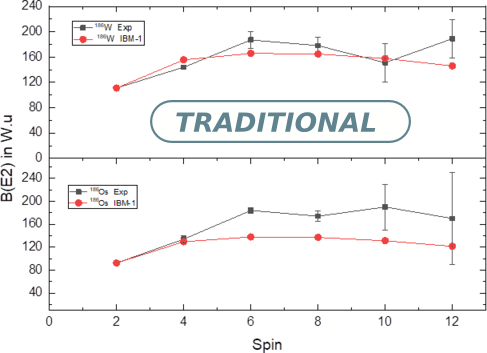Electric reduced transition probabilities of \(^{186}\text{W}\) and \(^{186}\text{Os}\) isobars through the interacting boson model-I
DOI:
https://doi.org/10.4279/pip.150005Keywords:
Reduced transition probabilities, 186W and 186Os nuclei, yrast state, deformation parameter, quadrupole momentsAbstract
In this study, we applied the Interacting Boson Model (IBM-I) to compute the electric reduced transition probabilities B(E2)\(\downarrow\) of even-even neutron rich \(^{186}\text{W}\) and \(^{186}\text{Os}\) isobars. The ratio \(R_{4/2} = E(4_{1}^{+}) / E(2_{1}^{+})\) has also been calculated for those isobars and the SU(3) symmetry for those isobars has been reported. \(E(4_{1}^{+})\) and \(E(2_{1}^{+})\) indicate the energy level of \(4_{1}^{+}\) and \(2_{1}^{+}\), respectively. We have described the strength of B(E2) in W.u. for \(^{186}\text{W}\) and \(^{186}\text{Os}\) isobars of some of the low-lying quadrupole collective states in contrast to obtainable measured data. The electric reduced transition probabilities B(E2)\(\downarrow\) from yrast state gamma transition from \(12_1^{+} \rightarrow 10_1^{+}\), \(10_1^{+} \rightarrow 8_1^{+}\), \(8_1^{+} \rightarrow 6_1^{+}\), \(6_1^{+} \rightarrow 4_1^{+}\), \(4_1^{+} \rightarrow 2_1^{+}\) and \(2_1^{+} \rightarrow 0_1^{+}\) and other bands states and B(E2) ratio of \(^{186}\text{W}\) and \(^{186}\text{Os}\) isobars have been compared with obtainable measured data and other previous studies. Also calculated were the systematic strength of B(E2), intrinsic quadrupole moments, and deformation parameters of even-even \(^{186}\text{W}\) and \(^{186}\text{Os}\) isobars. The data from these calculations are in good matching with the obtainable measured data. The IBM-I model for the strength of B(E2) has been systematically deduced in SU(3) limit for a few yrasts states transitions in \(^{186}\text{W}\) and \(^{186}\text{Os}\) isobars.

Downloads
Published
How to Cite
Issue
Section
License
Copyright (c) 2023 A Salam, Imam Hossain, Huda H. Kassim, Ahmed Saleh, A H H Alghanmi, Fadhil I Sharrad, N Aldahan

This work is licensed under a Creative Commons Attribution 4.0 International License.
Authors agree to the PIP Copyleft Notice













